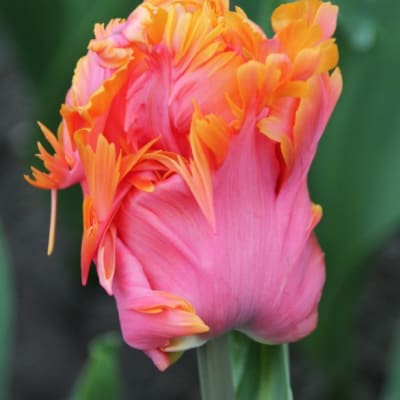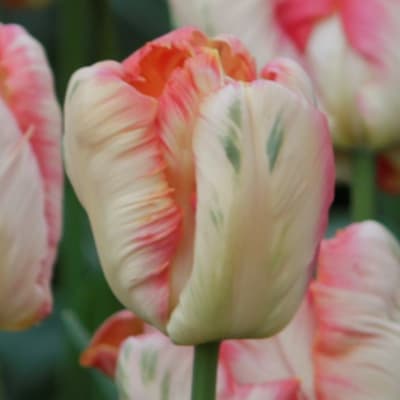Our web site works best with JavaScript. It looks like your browser
doesn't support it or it is turned off, so you might find that some
things don't work correctly. In particular, online ordering will not
work. We're sorry for any inconvenience.
Tulips
sale!
Quick View
Eye Catcher Mix
Tulip Bulbs
Ordering for this item is closed for the season
Tulipa Mid-spring blooms. A splashy mix of purples and white.
read more
sale!
Quick View
Tulipa Mid to late spring blooms. Better getchya burn permit for this fiery tulip mix.
read more
sale!
Quick View
Apeldoorn Elite
Darwin Hybrid Tulip Bulbs
Ordering for this item is closed for the season
Mid to late spring blooms. Stunning color combo!
read more
sale!
Quick View
Apricot Impression
Darwin Hybrid Tulip Bulbs
Ordering for this item is closed for the season
Mid to late spring blooms. Lustrous and glowing. Very popular for arrangements.
read more
sale!
Quick View
Apricot Pride
Darwin Hybrid Tulip Bulbs
Ordering for this item is closed for the season
Tulipa Mid to late spring blooms. Big 5" blooms in delicate antique hues.
read more
sale!
Quick View
Mid-spring blooms. A popular choice for landscapes. Long-lived, heat tolerant and grows well in part shade.
read more
sale!
Quick View
Daydream
Darwin Hybrid Tulip Bulbs
Ordering for this item is closed for the season
Mid to late spring blooms. A Fedco favorite. Fragrant and stunning.
read more
sale!
Quick View
Pink Impression
Darwin Hybrid Tulip Bulbs
Ordering for this item is closed for the season
Mid to late spring blooms. Impressive, handsome tulip is taller and larger than most, with gorgeous color gradations.
read more
sale!
Quick View
Purple Pride
Darwin Hybrid Tulip Bulbs
Ordering for this item is closed for the season
Mid to late spring blooms. The first purple Darwin Hybrid to hit the market; a long-standing classic.
read more
sale!
Quick View
Wedding Dress
Darwin Hybrid Tulip Bulbs
Ordering for this item is closed for the season
Tulipa Mid to late spring blooms. Delicate white blooms worthy of any spring celebration. Marvelous cutflower with strong stems.
read more
sale!
Quick View
Avant Garde
Double Early Tulip Bulbs
Ordering for this item is closed for the season
Early spring blooms. At once modern and classic. A proper wedding tulip!
read more
sale!
Quick View
Columbus
Double Early Tulip Bulbs
Ordering for this item is closed for the season
Early spring blooms. Raspberries and cream! Long lasting blooms on sturdy stems.
read more
sale!
Quick View
Early spring blooms. Fedco exclusive! Tulips in antique shades of gold, burgundy and cream.
read more
sale!
Quick View
Early spring blooms. Fedco exclusive! Like a spring rose garden, minus the thorns!
read more
sale!
Quick View
Foxtrot
Double Early Tulip Bulbs
Ordering for this item is closed for the season
Spring blooms. Award-winning tulip adds texture and classic color to gardens and arrangements.
read more
sale!
Quick View
Foxy Foxtrot
Double Early Tulip Bulbs
Ordering for this item is closed for the season
Spring blooms. We’re hot to trot for these big color-shifting extra foxy blooms. A great choice for bold arrangements.
read more
sale!
Quick View
Margarita
Double Early Tulip Bulbs
Ordering for this item is closed for the season
Early spring blooms. It's 5 o'clock somewhere! Large lively blooms with subtle fragrance.
read more
sale!
Quick View
Orca
Double Early Tulip Bulbs
Ordering for this item is closed for the season
Early to mid-spring blooms. Popular as a long-lasting fragrant cutflower. Glows in the garden and vase.
read more
sale!
Quick View
Palmyra
Double Early Tulip Bulbs
Ordering for this item is closed for the season
Early spring blooms. If a glass of Malbec were a tulip blossom.
read more
sale!
Quick View
Red Foxtrot
Double Early Tulip Bulbs
Ordering for this item is closed for the season
Tulipa Early spring blooms. We've all got red tulips, but none this foxy.
read more
sale!
Quick View
Valdivia
Double Early Tulip Bulbs
Ordering for this item is closed for the season
Early spring blooms. "Nothing gold can stay" but Valdivia comes close! Large fragrant blooms burst with petals.
read more
sale!
Quick View
Verona Sunrise
Double Early Tulip Bulbs
Ordering for this item is closed for the season
Early spring blooms. "Give me odorous at sunrise a garden of beautiful flowers" - Walt Whitman
read more
sale!
Quick View
Angelique
Double Late Tulip Bulbs
Ordering for this item is closed for the season
Late spring blooms. A classic romantic tulip if there ever was one.
read more
sale!
Quick View
Backpacker
Double Late Tulip Bulbs
Ordering for this item is closed for the season
Late spring blooms. An adventure for the eyes!
read more
sale!
Quick View
Black Hero
Double Late Tulip Bulbs
Ordering for this item is closed for the season
Late spring blooms. Rich scrumptious hues for the garden and vase.
read more
sale!
Quick View
Charming Beauty
Double Late Tulip Bulbs
Ordering for this item is closed for the season
Late spring blooms. Modern palette meets classic tulip charm.
read more
sale!
Quick View
Copper Image
Double Late Tulip Bulbs
Ordering for this item is closed for the season
Late spring blooms. Sensational and limited; get it while you can.
read more
sale!
Quick View
Creme Upstar
Double Late Tulip Bulbs
Ordering for this item is closed for the season
Late spring blooms. An award-winning multi-colored tulip that will catch everyone's eyes.
read more
sale!
Quick View
Double Gudoshnik
Double Late Tulip Bulbs
Ordering for this item is closed for the season
Late spring blooms. Bold and lavish peony-like blooms!
read more
sale!
Quick View
Double Negrita
Double Late Tulip Bulbs
Ordering for this item is closed for the season
Late spring blooms. Traditional bold rich purple.
read more
sale!
Quick View
Dream Touch
Double Late Tulip Bulbs
Ordering for this item is closed for the season
Late spring blooms. Dream a little dream of this artful beauty.
read more
sale!
Quick View
Late spring blooms. Fedco Exclusive! It’s the good angel on your shoulder whispering, “Buy more tulips.” Trust us.
read more
sale!
Quick View
La Belle Epoque
Double Late Tulip Bulbs
Ordering for this item is closed for the season
Late spring blooms. A modern hit, and in high demand. Get it while you can.
read more
sale!
Quick View
Mount Tacoma
Double Late Tulip Bulbs
Ordering for this item is closed for the season
Late spring blooms. An elegant snow-white heirloom. Complements any arrangement, in garden or vase.
read more
sale!
Quick View
Orange Princess
Double Late Tulip Bulbs
Ordering for this item is closed for the season
Late spring blooms. Regal in the garden and vase.
read more
sale!
Quick View
Pep Talk
Double Late Tulip Bulbs
Ordering for this item is closed for the season
Late spring blooms. Get stoked for these exciting and varying blooms.
read more
sale!
Quick View
Silk Road
Double Late Tulip Bulbs
Ordering for this item is closed for the season
Tulipa Late spring blooms. Big creamy modern blooms. No two are alike.
read more
sale!
Quick View
Sunlover
Double Late Tulip Bulbs
Ordering for this item is closed for the season
Late spring blooms. "Thou, sun, art half as happy as we" - John Donne
read more
sale!
Quick View
Orange Emperor
Fosteriana Tulip Bulbs
Ordering for this item is closed for the season
Early spring blooms. This emperor wears wonderfully orange clothes.
read more
sale!
Quick View
Red Emperor
Fosteriana Tulip Bulbs
Ordering for this item is closed for the season
Early spring blooms. Intense fiery reds for the tulip garden.
read more
sale!
Quick View
Brisbane
Fringed Tulip Bulbs
Ordering for this item is closed for the season
Mid to late spring blooms. Shabby-chic effusions of feathery petals add texture to bouquets.
read more
sale!
Quick View
Cummins
Fringed Tulip Bulbs
Ordering for this item is closed for the season
Mid to late spring blooms. Textured and ornate. Long-lasting in the garden and vase.
read more
sale!
Quick View
Labrador
Fringed Tulip Bulbs
Ordering for this item is closed for the season
Mid to late spring blooms. A beauty of botany, or science-fiction? You decide.
read more
sale!
Quick View
Lambada
Fringed Tulip Bulbs
Ordering for this item is closed for the season
Mid to late spring blooms. Like its namesake dance, vibrant and exuberant.
read more
sale!
Quick View
Ballerina
Lily-Flowered Tulip Bulbs
Ordering for this item is closed for the season
Late spring blooms. Graceful and timeless blossoms.
read more
sale!
Quick View
Marianne
Lily-Flowered Tulip Bulbs
Ordering for this item is closed for the season
Tulipa Late spring blooms. Exceptional fluted shape and spring color palette.
read more
sale!
Quick View
Merlot
Lily-Flowered Tulip Bulbs
Ordering for this item is closed for the season
Tulipa Late spring blooms. Finer than a glass of wine on a spring day.
read more
sale!
Quick View
Amazing Parrot
Parrot Tulip Bulbs
Ordering for this item is closed for the season
Late spring blooms. This is one special bird!
read more
sale!
Quick View
Apricot Parrot
Parrot Tulip Bulbs
Ordering for this item is closed for the season
Late spring blooms. A bird of a very different feather.
read more
sale!
Quick View
Black Parrot
Parrot Tulip Bulbs
Ordering for this item is closed for the season
Late spring blooms. Beloved heirloom with smaller blooms than other Parrot tulips. Adds panache to arrangements.
read more
Tulips
One of the world’s most beloved flowers, garden tulips have captivated hearts and inspired artists for centuries with their vibrant colors and elegant forms. Originating from the Ottoman Empire, these enchanting bulbs found their way to the Netherlands in the 16th century where they sparked an economic frenzy known as “Tulip Mania” after being identified as symbols of wealth and prosperity.
Tulips continue to enchant gardeners and enthusiasts alike with their versatility and charm. Their kaleidoscope of colors and shapes in the spring makes them ideal for a wide range of garden designs and arrangements. Whether planted in beds, borders or containers, tulips bring a touch of elegance and joy to any landscape. Most varieties are also good for cutting, and many are good for forcing. See our tulip comparison chart for further reference.
To help protect your tulips from marauding critters, try interplanting with genera that are unattractive to pests, like Allium , Fritillaria and Narcissus .
Garden Tulips are hardy in Zones 3-7, unless otherwise noted. All our tulip bulbs measure at least 12cm, unless specified.
Planting Tulips for Longevity Some gardeners treat tulips like annuals and buy new ones every year, while others painstakingly dig their bulbs up in summer after the foliage has browned and store them to replant in the fall.
If (like us) you are thrifty and/or lazy, there’s an easier way to encourage tulips to come back year after year. Choose a sunny location and plant the bulbs 8–10" deep (yes, that deep!) in well-drained soil, 3–4 weeks before the ground freezes.
During spring growth, check the soil weekly if there is little rain, and water if 1/2" below the surface is dry. Deadhead to force the plant’s energy into the bulb. Don’t cut or tie the foliage until it has begun to yellow. Overplant with annuals or perennials to help keep the soil dry down where the bulb is.



















































